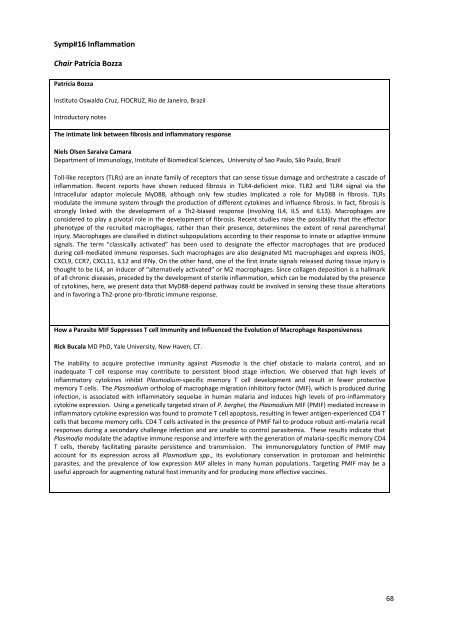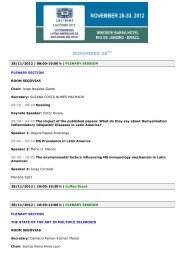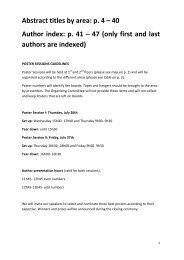Keynote Conference - Interevent
Keynote Conference - Interevent
Keynote Conference - Interevent
Create successful ePaper yourself
Turn your PDF publications into a flip-book with our unique Google optimized e-Paper software.
Symp#16 Inflammation<br />
Chair Patrícia Bozza<br />
Patrícia Bozza<br />
Instituto Oswaldo Cruz, FIOCRUZ, Rio de Janeiro, Brazil<br />
Introductory notes<br />
The intimate link between fibrosis and inflammatory response<br />
Niels Olsen Saraiva Camara<br />
Department of Immunology, Institute of Biomedical Sciences, University of Sao Paulo, São Paulo, Brazil<br />
Toll-like receptors (TLRs) are an innate family of receptors that can sense tissue damage and orchestrate a cascade of<br />
inflammation. Recent reports have shown reduced fibrosis in TLR4-deficient mice. TLR2 and TLR4 signal via the<br />
intracellular adaptor molecule MyD88, although only few studies implicated a role for MyD88 in fibrosis. TLRs<br />
modulate the immune system through the production of different cytokines and influence fibrosis. In fact, fibrosis is<br />
strongly linked with the development of a Th2-biased response (involving IL4, IL5 and IL13). Macrophages are<br />
considered to play a pivotal role in the development of fibrosis. Recent studies raise the possibility that the effector<br />
phenotype of the recruited macrophages, rather than their presence, determines the extent of renal parenchymal<br />
injury. Macrophages are classified in distinct subpopulations according to their response to innate or adaptive immune<br />
signals. The term “classically activated” has been used to designate the effector macrophages that are produced<br />
during cell-mediated immune responses. Such macrophages are also designated M1 macrophages and express iNOS,<br />
CXCL9, CCR7, CXCL11, IL12 and IFNγ. On the other hand, one of the first innate signals released during tissue injury is<br />
thought to be IL4, an inducer of “alternatively activated” or M2 macrophages. Since collagen deposition is a hallmark<br />
of all chronic diseases, preceded by the development of sterile inflammation, which can be modulated by the presence<br />
of cytokines, here, we present data that MyD88-depend pathway could be involved in sensing these tissue alterations<br />
and in favoring a Th2-prone pro-fibrotic immune response.<br />
How a Parasite MIF Suppresses T cell Immunity and Influenced the Evolution of Macrophage Responsiveness<br />
Rick Bucala MD PhD, Yale University, New Haven, CT.<br />
The inability to acquire protective immunity against Plasmodia is the chief obstacle to malaria control, and an<br />
inadequate T cell response may contribute to persistent blood stage infection. We observed that high levels of<br />
inflammatory cytokines inhibit Plasmodium-specific memory T cell development and result in fewer protective<br />
memory T cells. The Plasmodium ortholog of macrophage migration inhibitory factor (MIF), which is produced during<br />
infection, is associated with inflammatory sequelae in human malaria and induces high levels of pro-inflammatory<br />
cytokine expression. Using a genetically targeted strain of P. berghei, the Plasmodium MIF (PMIF) mediated increase in<br />
inflammatory cytokine expression was found to promote T cell apoptosis, resulting in fewer antigen-experienced CD4 T<br />
cells that become memory cells. CD4 T cells activated in the presence of PMIF fail to produce robust anti-malaria recall<br />
responses during a secondary challenge infection and are unable to control parasitemia. These results indicate that<br />
Plasmodia modulate the adaptive immune response and interfere with the generation of malaria-specific memory CD4<br />
T cells, thereby facilitating parasite persistence and transmission. The immunoregulatory function of PMIF may<br />
account for its expression across all Plasmodium spp., its evolutionary conservation in protozoan and helminthic<br />
parasites, and the prevalence of low expression MIF alleles in many human populations. Targeting PMIF may be a<br />
useful approach for augmenting natural host immunity and for producing more effective vaccines.<br />
68





